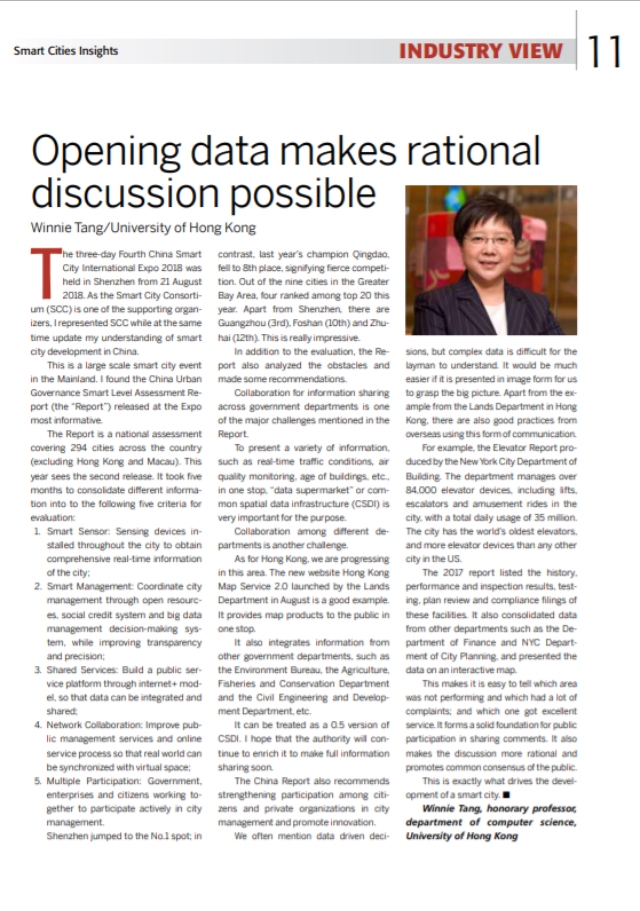
Opening data makes rational discussion possible
The three-day Fourth China Smart City International Expo 2018 was held in Shenzhen starting from 21 August 2018. As the Smart City Consortium (SCC) is one of the supporting organizers, I represented SCC to join the event while at the same time to update my understanding of smart city development in China.
This is a large scale smart city event in the Mainland. I found the China Urban Governance Smart Level Assessment Report (the “Report”) released at the Expo most informative.
The Report is a national assessment covering 294 cities across the country (excluding Hong Kong and Macau). This year sees the second release. It took five months to consolidate different information, such as literature review, telephone interviews and public data collection according to the following five criteria for evaluation:
1. Smart Sensor: Sensing devices installed throughout the city to obtain comprehensive and real-time information of the city;
2. Smart Management: Coordinate city management through open resources, social credit system and big data management decision-making system, while improving transparency and precision;
3. Shared Services: Build a public service platform through internet+ model, so that data can be integrated and shared;
4. Network Collaboration: Improve public management services and online service process so that real world can be synchronized with virtual space;
5. Multiple Participation: Government, enterprises and citizens work together to participate actively in city management.
Shenzhen only ranked 5th in last year's evaluation, this year the city has jumped to No.1; on the contrary, last year's champion Qingdao, falls to the 8th place, signifying a fierce competition. Out of the nine cities in the Greater Bay Area, four ranked among top 20 this year. Apart from Shenzhen, there are Guangzhou (3rd), Foshan (10th) and Zhuhai (12th). This is really impressive.
In addition to the evaluation, the Report also analysed the obstacles and made some recommendations.
Collaboration for information sharing across government departments is one of the major challenges mentioned in the Report.
To present a variety of information, whether it is real-time traffic conditions, air quality monitoring, age of buildings, etc., in one stop, "data supermarket" or common spatial data infrastructure (CSDl) is very important for the purpose.
To secure collaboration among various government department is always a challenge to every city.
How about Hong Kong? Fortunately, we are progressing in this area. The new website Hong Kong Map Service 2.0 launched by the Lands Department at end August is a good example. It provides map products to the public in one stop.
Furthermore, it also integrates information from other government departments, such as the Environment Bureau, the Agriculture, Fisheries and Conservation Department and the Civil Engineering and Development Department, etc.
It can be treated as a 0.5 version of CSDl. I hope that the authority will continue to enrich it to make full information sharing soon.
The China Report also recommends strengthening participation among citizens and private organizations in city management and promoting innovation.
We often mention data driven decisions, but complex data is difficult for the layman to understand. It would be much easier if it is presented in image form for us to grasp the big picture. Apart from the example from the Lands Department in Hong Kong, there are also good practice from overseas using this means of communication.
For example, the Elevator Report produced by New York City Department of Buildings (DOB). The department manages over 84,000 elevator devices, including lifts, escalators and amusement rides in the city, with a total daily usage of 35 million times. The city has the world’s oldest elevators, and more elevator devices than any other city in the U.S.
The 2017 report listed the history, the performance and inspection results, testing, plan review and compliance filings of these facilities. It also consolidated data from other departments such as the Department of Finance and NYC Department of City Planning, and presented the data on an interactive map.
Therefore, it is easy to tell which area was not performing and which had a lot of complaints; and which one got excellent service. It forms a solid foundation for public participation in sharing comments. It also makes the discussion more rational and promotes common consensus of the public.
This is exactly what drives the development of a smart city.
Dr. Winnie Tang
Honorary Professor, Department of Computer Science, The University of Hong Kong